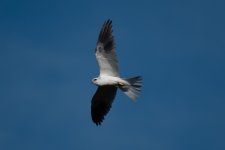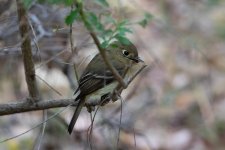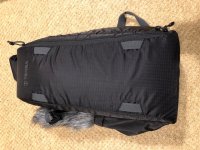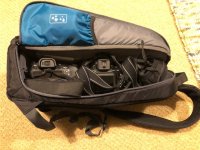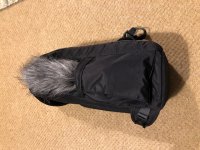I want to share here some thoughts I have on the RX10 iv, mostly around how it compares to using a DSLR. Though I think this is a great camera, I focus on negatives here, with the goal of helping DLSR owners better understand where they might get frustrated if switching to this camera.
I bought the RX10 iv to use in addition to my D7200 + 80-400mm. On the whole, I really like the RX10. I use it probably half the time I’m out birding now, with the other half being given to the D7200. The Sony has a lot of upside over the DSLR, much of which has already been discussed in this thread. It creates excellent images, has accurate and laser-fast autofocus, and does well with birds perched amid branches as well as those in flight. I would not however consider it as a “replacement” for the D7200. It falls short in some key areas and can be frustrating to use (for me). The shortcomings that have been most noticeable to me have to do with the usage and handling, interface, and tremendously short battery life. These are my opinions and I’m sure others will disagree here and there. I tend to be nitpicky about some of these things, so you might not find these faults to be very important at all.
My notes (again, mostly in the context of how it compares to using the D7200):
** Relatively clumsy to use
- The menu navigation can be slow when changing camera settings. I primarily use 2 memory presets, one for perched birds and one for BIF. I often find myself wanting to quickly switch from one to the other, but the camera makes it rather slow. On the DSLR it takes only a fraction of a second.
- Zooming in and out is also slower than on a DSLR, but this is to be expected. Also, I usually find the speed to be adequate.
** Image review is slow and clumsy.
- When reviewing photos, zooming in and out is slow with poor responsiveness. Switching from one image to the next while zoomed is very slow.
- The camera doesn’t really do auto image review like a DSLR does. You have to hit the play button to review a photo instead of automatically being shown the photo you just took. Yes, you can turn on auto-review, but this feature is very disruptive in that it will always automatically display your photo in the EVF. This basically makes the feature useless, as it disrupts your shooting. And who would ever want to review a photo in the EVF?! Anyway, I’ve gotten used to hitting the play button. Just makes things a tad slower to use (there is a theme here).
** Touchscreen no good (for me). I would constantly accidentally touch it with my nose or finger, causing the focus point to change. I turned off the touchscreen within the first week and have never turned it on. That said, I don’t really miss it.
** Battery life, at least compared to a DSLR, is fantastically bad. I haven’t done a true comparison, but I’d reckon the D7200 battery lasts at least 8 or 10x as long as the Sony. If I take the RX10 out for an hour keeping the camera on but taking zero photos, it will drain the battery about 20%. This is no doubt partly due to the fact that the LCD screen stays on all the time. I don’t know why they designed it like that, but it does. There are some workarounds to make it stay off (some discussed previously in this thread), but they are clumsy at best and have their own drawbacks. In the end, the battery thing isn’t too bad, you just have to stock up on batteries.
** EVF – The EVF has been harder to use for me than an OVF of a DLSR. I have largely gotten used to it, but it generally takes a second for my eye to adjust to it when I go to take a shot. It can be harder (sometimes impossible) to find distant or fast-moving birds that would be easy with the D7200. But on the whole this is usually not an issue, with it only falling short in these more difficult scenarios.
** There is no user manual. This is frustrating. An online version exists but is, surprise surprise, clumsy and difficult to navigate.
I will wrap up by saying again that I love this camera and get a lot of great use out of it. It performs exceptionally well at taking photos and I have gotten some great images of birds. I can’t speak to technical IQ like some of the pros and enthusiasts around here, but it’s been great for me. I still have a lot to learn about how to use it, and I hope to start shooting video soon. Some samples here. Nothing great, but perhaps these show a bit of the camera's focusing versatility.
I bought the RX10 iv to use in addition to my D7200 + 80-400mm. On the whole, I really like the RX10. I use it probably half the time I’m out birding now, with the other half being given to the D7200. The Sony has a lot of upside over the DSLR, much of which has already been discussed in this thread. It creates excellent images, has accurate and laser-fast autofocus, and does well with birds perched amid branches as well as those in flight. I would not however consider it as a “replacement” for the D7200. It falls short in some key areas and can be frustrating to use (for me). The shortcomings that have been most noticeable to me have to do with the usage and handling, interface, and tremendously short battery life. These are my opinions and I’m sure others will disagree here and there. I tend to be nitpicky about some of these things, so you might not find these faults to be very important at all.
My notes (again, mostly in the context of how it compares to using the D7200):
** Relatively clumsy to use
- The menu navigation can be slow when changing camera settings. I primarily use 2 memory presets, one for perched birds and one for BIF. I often find myself wanting to quickly switch from one to the other, but the camera makes it rather slow. On the DSLR it takes only a fraction of a second.
- Zooming in and out is also slower than on a DSLR, but this is to be expected. Also, I usually find the speed to be adequate.
** Image review is slow and clumsy.
- When reviewing photos, zooming in and out is slow with poor responsiveness. Switching from one image to the next while zoomed is very slow.
- The camera doesn’t really do auto image review like a DSLR does. You have to hit the play button to review a photo instead of automatically being shown the photo you just took. Yes, you can turn on auto-review, but this feature is very disruptive in that it will always automatically display your photo in the EVF. This basically makes the feature useless, as it disrupts your shooting. And who would ever want to review a photo in the EVF?! Anyway, I’ve gotten used to hitting the play button. Just makes things a tad slower to use (there is a theme here).
** Touchscreen no good (for me). I would constantly accidentally touch it with my nose or finger, causing the focus point to change. I turned off the touchscreen within the first week and have never turned it on. That said, I don’t really miss it.
** Battery life, at least compared to a DSLR, is fantastically bad. I haven’t done a true comparison, but I’d reckon the D7200 battery lasts at least 8 or 10x as long as the Sony. If I take the RX10 out for an hour keeping the camera on but taking zero photos, it will drain the battery about 20%. This is no doubt partly due to the fact that the LCD screen stays on all the time. I don’t know why they designed it like that, but it does. There are some workarounds to make it stay off (some discussed previously in this thread), but they are clumsy at best and have their own drawbacks. In the end, the battery thing isn’t too bad, you just have to stock up on batteries.
** EVF – The EVF has been harder to use for me than an OVF of a DLSR. I have largely gotten used to it, but it generally takes a second for my eye to adjust to it when I go to take a shot. It can be harder (sometimes impossible) to find distant or fast-moving birds that would be easy with the D7200. But on the whole this is usually not an issue, with it only falling short in these more difficult scenarios.
** There is no user manual. This is frustrating. An online version exists but is, surprise surprise, clumsy and difficult to navigate.
I will wrap up by saying again that I love this camera and get a lot of great use out of it. It performs exceptionally well at taking photos and I have gotten some great images of birds. I can’t speak to technical IQ like some of the pros and enthusiasts around here, but it’s been great for me. I still have a lot to learn about how to use it, and I hope to start shooting video soon. Some samples here. Nothing great, but perhaps these show a bit of the camera's focusing versatility.




